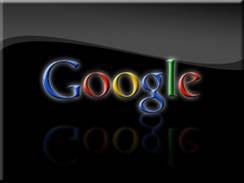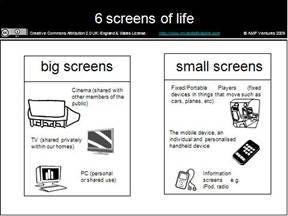Digital Strategy: Only the paranoid survive!
I wrote the original post in March 2010, about the screens of life and the competition to get in your data from the server to the brighly lit screen.
- The Six screens of life become 7 #mdfp

Dark Screen
When writing my digital footprint I updated the Six screen’s of life work originally developed for mobile web 2.0 (extract on read/write web) However, I have now realised that I missed one out.
What is said in summary is that for the most part, we are consumers of content. In our daily lives we consume professionally created, produced and edited content from traditional and new media providers on our ‘six screens of life’. These screens are divided into two broad categories, big screens and small screens, each with three subgroups as per figure 2.

6 screens of life
Both for big and small screens, the user has traditionally been a passive receiver of content (content has been broadcast to the user) or the user has been seen as a member of a carefully controlled and managed audience (e.g. voting) — but not as a primary creator of content.
Both for big and small screens, the user has traditionally been a passive receiver of content (content has been broadcast to the user) or the user has been seen as a member of a carefully controlled and managed audience (e.g. voting) — but not as a primary creator of content.
For instance:
- both TV and cinema need users to consume (view); and
- a website needs users to consume/interact in most cases.
Reflectingthe above trend, most of the content on the mobile device to date has also been the ‘re-presentation’ and ‘reproduction’ of existing material delivered to the mobile screen. The mobile device, however, is changing from being a primary consumer to a major creator of content. It is worth noting at this point that the separate screens of life don’t have to be managed or offered by separate service providers, devices will no longer control what you can do and where, instead the screen will be able to come under the control of the user, with services relevant to the size of the screen. However, least we forget that the interactive age of communicates and social media delivers diversity and innovation, broadcast amplifies.
The missing one is as obvious as the one’s in front of you as it is the one you don’t look at. The seventh screen it is the “dark screen”, the screen that is off the bottom of the lit screen. Why is this dark screen important, as it is the one that represents your scrolling that means some content has just gone or is the one that someone is trying to be lit up for you. 99.999% of the internet is dark screen. The data and information is there is it just not lit.
Why was I thinking about this? I have been working out how long a Tweet is relevant for as it moves from the top of the list, down to the unlit portion of your web page. Have some interesting data on this ready for the next blog.
Update:
screen time competition and why the screens of life needs new thinking!
If we think about the game to get from the dark screen to the lit screen — where value is created; these are the games to play.
- game 1 = get from dark to lite (startup, survival, funding, proof)
- game 2 = get on the lit (more) often (habit forming)
- game 3 = have a bigger share of screen time (growth)
- game 4 = be the priority of the screen time (value for shareholders and control over access, eco-system and market)
Each of these presents differet strategic issues, the big one is when at game 4 as now not competting with others who are like you but with everyone who wants eyes on. Think: Netflick vs Forghnight
Stimulted from reading “How to fight a competitor that does not appear on your radar?” by Danny Peled https://medium.com/p/4e8cbcafa3ba